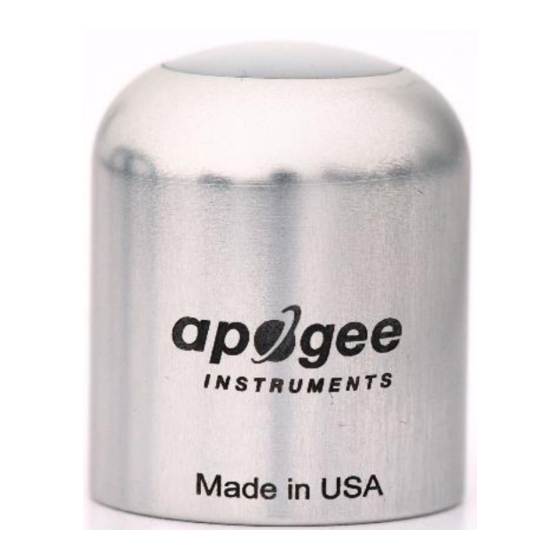Table of Contents
Advertisement
Quick Links
Advertisement
Table of Contents

Subscribe to Our Youtube Channel
Summary of Contents for Apogee Instruments SU-202
-
Page 1: Owner's Manual
OWNER’S MANUAL ULTRAVIOLET-A SENSOR Models SU-202 and SU-205 (including SS models) APOGEE INSTRUMENTS, INC. | 721 WEST 1800 NORTH, LOGAN, UTAH 84321, USA TEL: (435) 792-4700 | FAX: (435) 787-8268 | WEB: APOGEEINSTRUMENTS.COM Copyright © 2020 Apogee Instruments, Inc. -
Page 2: Table Of Contents
TABLE OF CONTENTS Owner’s Manual ....................................1 Certificate of Compliance ................................. 3 Introduction ..................................... 4 Sensor Models ..................................5 Specifications ................................... 6 Deployment and Installation ..............................9 Cable Connectors ................................... 10 Operation and Measurement ..............................11 Maintenance and Recalibration ............................. 14 Troubleshooting and Customer Support .......................... -
Page 3: Certificate Of Compliance
RoHS 3 compliant using exemption 6c. Further note that Apogee Instruments does not specifically run any analysis on our raw materials or end products for the presence of these substances, but rely on the information provided to us by our material suppliers. -
Page 4: Introduction
Most UV sensors designed for sunlight measurements are sensitive to UV radiation in the UV-A or UV-B ranges. Apogee Instruments SU-200 series UV-A sensors detect UV radiation from 300 to 400 nm and are calibrated in energy flux density units of watts per square meter (W m , equal to Joules per second per square meter). -
Page 5: Sensor Models
SENSOR MODELS This manual covers the amplified model SU-202 and SU-205 UV-A sensors (listed below in bold). Additional models are covered in their respective manuals. Model Signal SU-200 0-10 mV SU-202 0- 2.5 V SU-205 0- 5 V Sensor model number and serial number are located on the bottom of the sensor. -
Page 6: Specifications
SPECIFICATIONS SU-202-SS SU-205-SS Power Supply 3.3 to 24 V DC 5.5 to 24 V DC 25 mV per W m 50 mV per W m Output (sensitivity) 8.33 mV per µmol m⁻² s⁻¹ 16.67 mV per µmol m⁻² s⁻¹ Calibration Factor (reciprocal of 0.04 W m... - Page 7 Cosine Response Directional, or cosine, response is defined as the measurement error at a specific angle of radiation incidence. Directional error for Apogee SU-200 series UV-A sensors is approximately ± 2 % and ± 5 % at solar zenith angles of 45°...
- Page 8 Spectral Response Spectral response estimate of Apogee SU- 200 UV-A sensors. Spectral response was modeled from sensitivity of the photodetector and transmittance of the diffuser.
-
Page 9: Deployment And Installation
Mount the sensor to a solid surface with the nylon mounting screw provided. To accurately measure UV-A incident on a horizontal surface, the sensor must be level. An Apogee Instruments model AL-100 Leveling Plate is recommended to level the sensor when used on a flat surface or being mounted to surfaces such as wood. To facilitate mounting on a mast or pipe, the Apogee Instruments model AL-120 Solar Mounting Bracket with Leveling Plate is recommended. -
Page 10: Cable Connectors
CABLE CONNECTORS Apogee sensors offer cable connectors to simplify the process of removing sensors from weather stations for calibration (the entire cable does not have to be removed from the station and shipped with the sensor). The ruggedized M8 connectors are rated IP68, made of corrosion-resistant marine-grade stainless-steel, and designed for extended use in harsh environmental conditions. -
Page 11: Operation And Measurement
UV sensor. The amplification circuit requires a power supply of 3.3 to 24 V DC (SU-202) or 5.5 to 24 V DC (SU-205). NOTE: to prevent sensor damage, DO NOT connect the sensor to a power source greater than 24 V DC. - Page 12 Sensor Calibration All Apogee amplified UV sensor models SU-202 and SU-205 have a standard UV calibration factor of exactly: SU-202: 0.04 W m per mV SU-205: 0.02 W m per mV The following example uses the SU-202 calibration factor and expected response under full sunlight: Calibration Factor (0.04 W m...
- Page 13 UV-A Measurements and Spectral Errors Apogee Instruments model SU-200 UV-A sensors are calibrated to measure ultraviolet radiation from the sun between 300 and 400 nm in Watts per square meter. In addition to naturally occurring UV-A radiation from the sun, there are many electric light sources that emit UV-A radiation (e.g., cool white fluorescent, metal halide, mercury arc, and germicidal lamps).
-
Page 14: Maintenance And Recalibration
MAINTENANCE AND RECALIBRATION Blocking of the optical path between the target and detector can cause low readings. Occasionally, accumulated materials on the diffuser of the SU-200 series UV-A sensors can block the optical path in three common ways: 1. Moisture or debris build-up on the diffuser. 2. -
Page 15: Troubleshooting And Customer Support
TROUBLESHOOTING AND CUSTOMER SUPPORT Independent Verification of Functionality Apogee SU-202 and SU-205 sensors provide an amplified voltage output that is proportional to incident UV-A radiation. A quick and easy check of sensor functionality can be determined using a DC power supply and a voltmeter. - Page 16 Unit Conversion SU-200 series UV-A sensors are calibrated in energy flux units of W m . It is possible to convert the energy flux value to photon flux units of µmol m using a conversion factor. Below is an example of how to convert energy flux units to photon flux.
-
Page 17: Return And Warranty Policy
RETURN AND WARRANTY POLICY RETURN POLICY Apogee Instruments will accept returns within 30 days of purchase as long as the product is in new condition (to be determined by Apogee). Returns are subject to a 10 % restocking fee. WARRANTY POLICY... - Page 18 5. Upon receipt, Apogee Instruments will determine the cause of failure. If the product is found to be defective in terms of operation to the published specifications due to a failure of product materials or craftsmanship, Apogee Instruments will repair or replace the items free of charge.

















Need help?
Do you have a question about the SU-202 and is the answer not in the manual?
Questions and answers